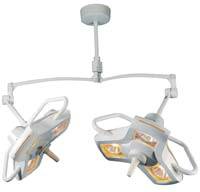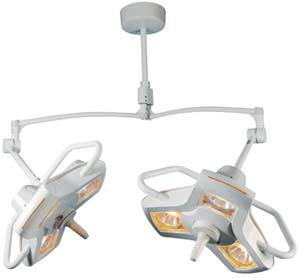Home » Hospital & Durable Medical Equipment » Innovative Surgical & Exam Lighting Delivers Optimal Illumination » Innovative Surgical & Exam Lighting Delivers Optimal Illumination
Innovative Surgical & Exam Lighting Delivers Optimal Illumination

Double Ceiling Mount Light w/ Limitless Rotation
Retail Price: $6,973.66
Your Price: $5,165.68

Major Surgery Double Ceiling Mount Light
Retail Price: $8,115.32
Your Price: $6,011.35

Isis Double Ceiling Mount Minor Surgery Light
Retail Price: $5,607.18
Your Price: $5,241.04
 Unit: single
Unit: single
- Space available - Space influences light placement. A ceiling or wall mounted light may be the most practical lighting, keeping floor space free. However, if there is a need for movable lighting, the floor stand light is a better option.
- Type of procedures requiring lighting – Some procedures require deep cavity searches versus surface examinations. Surgical lighting is designed specifically for minor surgery versus major surgery, or a light procedure examination versus an in-depth examination. The reason there are so many lighting options is that there are so many types of medical procedures. Sometimes lighting needs to have a wide field of light, but other times the light needs to be focused on a particular spot
- Type of lighting – Most surgical lighting and medical examination lights today use halogen bulbs or LED lights. The lighting will have a Color Rendering Index (CRI) which refers to the ability of a light to show colors realistically or similar to how the colors would appear in natural light or incandescent light. The highest CRI is 100, and the nearer a light's CRI to 100, the more natural colors will appear. Shadow control and the amount of glare the light produces are additional factors to consider.
- Lighting will also have a Kelvin (K) rating which is a measure of the light appearance or color temperature on a scale of 1,000-10,000. The color temperature refers to the amount of difference between a true white color and the red, yellow and blue colors in a light. Lights cover a range of warm to cool. For example, a 3700 K color temperature is a natural white or softer white light.
- Mobility– Mobility refers to the ability to easily move the light. Some floorstand lights have wheels for easy placement.
- Arm flexibility – Floorstand and mounted lights have some degree of flexibility. Ideally, the arm moves up and down and in a parallel motion. The floorstand arm is flexible and easily shifted to shine on the desired spot. Mounted lights are also flexible and have knobs that make it easy to move the arms.
- Heat production – High-quality lights have a heat absorbing dichroic filter so the light does not get too hot and present a safety hazard.
- Light features – Floorstand lamps are made in different heights. Concerning all lighting, there are different lamp head sizes, volts, wattages, bulb life, diameter of the light's viewing area and CE marking to consider. CE marking is a quality designation, indicating the device meets the manufacturer's claims and is safe to use for the intended purpose.
- Budget – Lamps vary in price depending on the number and type of features. Prices range from as low as $50 to $4,000 or more. Hospitals purchasing a large number of lights can usually request a volume discount.
- Warranty – All lights should have at least a manufacturer's limited warranty. Extended warranties are available on higher priced lights.
- Quality in lighting is important to ensure it performs as expected. For example, the lighting arms need to remain positioned when moved, the lighting should be flicker-free and the construction should be durable.
- Ceiling or wall mounted lights – There are single or double mount lights. Light options include small fields of illumination for close medical examinations or a larger field of illumination for general surgery.
- Floorstand lights – Floorstand lights are exactly what the name implies. They have a base with an attached pole and a flexible neck. They are manufactured with or without magnifiers.
- Hand held light magnifier light – These are portable lights for examinations. There are general use hand held lights, and models made for specific purposes, like the portable ultra-violet wood lamp for head lice diagnosis or other types of infestations, infections, skin injuries, etc. Handheld lights are also manufactured for lightweight medical examinations.
- Mounted gooseneck lamp – This is an LED light designed to mount on a counter or other examination table for lighting a small area. It is ideal for use in small or confined spaces too.
- Headlights – Some companies sell surgical and examination headlights. The fiber optic or LED lights are attached to a head strap and worn on the head.
- Recessed – There are also recessed surgical lights sold which are lights installed in walls or ceilings.
- Floorstand models – Models are made with adjustable heights of 30-70 inches. This model has a movable flexible arm and a 6.5-inch diameter or larger circular viewing area.
- Mounted models – Models include a single or double light that can be hung on the ceiling or wall. It is ideal for rooms with limited floor space.
- Bulbs – Depending on the light selected, bulbs range from single 22-watts to three 50-watt halogen bulbs. Bulb life ranges from 2,000-10,000 hours.
- Lux and Lumen – Lux is a unit of measurement of light level intensity in an area. Lux also varies, depending on the light chosen. Higher priced surgical lighting can have as much as 120,000 lux on a 24-inch diameter bulb. Lumens are the amount of radiated light, a specification found in smaller lights. The gooseneck lamp LED light produces 200 lumens.
- Cool operation – To prevent overheating, high-quality lights have heat-filters and dichroic coatings. Dichroic coatings perform like filters, reflecting light to keep the light and the surrounding area cool.
- Optional features – Floorstand lights may come with a footswitch for hands-free operation, locking casters, cord wrap and/or ventilated parabolic shade. To keep the equipment clean, some floodlight and mounted models can accommodate accessories like disposable handle covers which eliminate the need to sterilize handles in an autoclave.
- Voltage - Other than the handheld lights, voltage models include 115V, 120V, and 230V. Handheld ultraviolet lights use small UV bulbs, like 2V.














